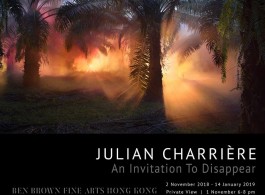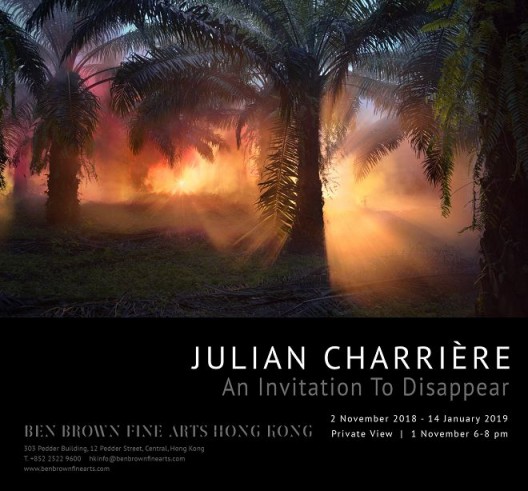An Invitation to Disappear
Ben Brown Fine Arts
Hong Kong
Ben Brown Fine Arts is pleased to present our first solo exhibition with Julian Charrière, An Invitation to Disappear, at the Hong Kong gallery. Charrière is a conceptual artist whose work includes installation, performance, sculpture, video and photography, often informed by his expeditions to remote, geologically imperiled parts of the world. His work offers a poignant reflection and vital commentary on the effects of mankind on the Earth’s precious and fleeting resources, and how rapidly our cultural and geological landscapes are shifting.
Having studied under Olafur Eliasson at the Institut für Raumexperimente (Institute for Spatial Experiments) in Berlin, this Swiss-French artist’s work is fueled by his fieldwork in environmentally jeopardized areas, including icebergs, salt mines, radioactive sites, volcanoes, rainforests and the deep sea. Charrière is drawn to the friction between nature and technology, and the destruction of natural resources under the pretext of human advancement, envisioning a dystopian future with little resemblance to the natural state of our planet.
The departure point of Charrière’s current exhibition is the 200th anniversary of the eruption of Tambora, a volcano on the Indonesian island of Sumbawa. Tambora, which forebodingly translates to “an invitation to disappear”, was the largest volcanic eruption in recorded human history and resulted in plummeting temperatures, agricultural disaster, extreme weather, floods and famine around the world. Clouds of ash spread as far as Europe and North America, paradoxically yielding radiant sunsets which are said to have influenced the landscape paintings of J. M. W. Turner and Caspar David Friedrich.
In 2017, Charrière hiked to the base of Tambora, having passed through vast expanses of non-native oil palm plantations during his trek. The booming palm oil industry has resulted in massive deforestation, an infiltration of pesticides, and the displacement and extinction of indigenous wildlife, primarily in Indonesia and Malaysia. Palm oil, derived from the bright red and orange fruits of the oil palm, is a cheap and ubiquitous ingredient found in nearly half of all packaged food and beauty products. The oil palms are planted in rigid grid-like arrangements over such large swathes of land that when viewed aerially create a stippled pattern of dots, the topography of the Earth literally altered by this industry.
Charrière analogizes these two catastrophic moments in Indonesian history—one a natural phenomenon and the other manmade— and their ramifications globally. Inspired by Heinrich Bechtolsheimer’s description of the sunsets seen in the Rheinhessen region of Germany in 1816 as a result of Tambora’s volcanic matter floating in the atmosphere (“the glowing sunset lit up the western sky like an expansive luminous conflagration; yellow, violet and red lights flickered here and there”), Charrière chose to create a rave deep in the fields of the oil palm plantations not far from Tambora, replete with smoke machines, flashing lights, and loops of electronic music, taking place from dawn until dusk. His rave was devoid of people, only captured in a video and film stills, a metaphor for human isolation, destruction and a dystopian future landscape; the collective trance of a rave symbolizing our ignorant consumption of palm oil. The photographs in the exhibition, all culled from the staged rave, present sublimely beautiful landscapes of drooping palm fronds silhouetted against supernatural backdrops of glowing colours and a hazy, fiery light source, suggesting at once the beginning and end of time.
Also included in the exhibition is a totemic teak pillar, To Observe is to Influence, that has been incised, and burnt over, with imagery of rainforests based on the prints of Alfred Russel Wallace, the 19th century British explorer, biologist and anthropologist. During his fieldwork in the Malay Archipelago, Wallace identified the faunal boundary between Asian and Australian which runs through Indonesia, now termed the Wallace Line, and was one of the first scientists to warn of the consequences of deforestation on climate, particularly in the rainforests. The sculpture Love-Inis a handmade “lava lamp”, a 1960s icon of counterculture and the peace movement, fueled by palm oil. An Invitation to Disappear is an extensive, multi-media project that was first exhibited at Kunsthalle Mainz, Germany, while the film of the rave has been shown at Berlin’s infamous nightclub, Berghain.




